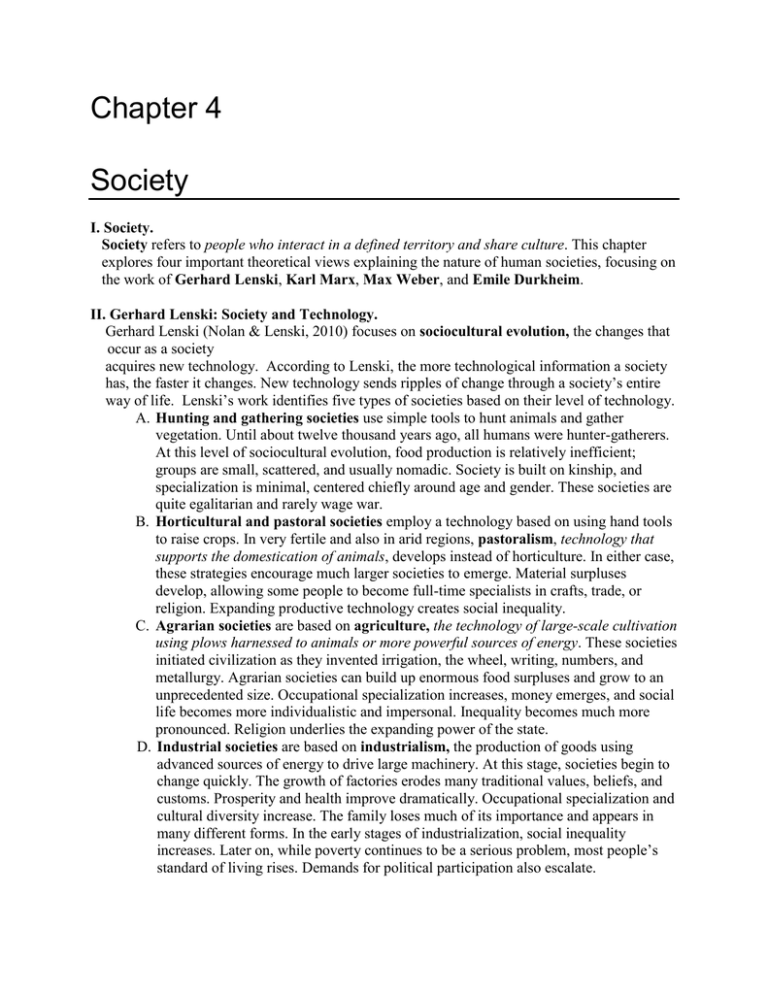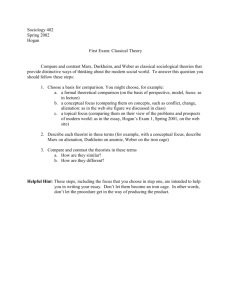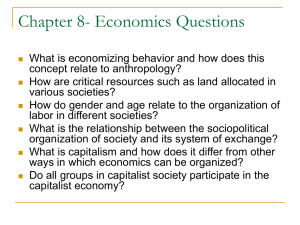Chapter 4 Society
advertisement

Chapter 4 Society I. Society. Society refers to people who interact in a defined territory and share culture. This chapter explores four important theoretical views explaining the nature of human societies, focusing on the work of Gerhard Lenski, Karl Marx, Max Weber, and Emile Durkheim. II. Gerhard Lenski: Society and Technology. Gerhard Lenski (Nolan & Lenski, 2010) focuses on sociocultural evolution, the changes that occur as a society acquires new technology. According to Lenski, the more technological information a society has, the faster it changes. New technology sends ripples of change through a society’s entire way of life. Lenski’s work identifies five types of societies based on their level of technology. A. Hunting and gathering societies use simple tools to hunt animals and gather vegetation. Until about twelve thousand years ago, all humans were hunter-gatherers. At this level of sociocultural evolution, food production is relatively inefficient; groups are small, scattered, and usually nomadic. Society is built on kinship, and specialization is minimal, centered chiefly around age and gender. These societies are quite egalitarian and rarely wage war. B. Horticultural and pastoral societies employ a technology based on using hand tools to raise crops. In very fertile and also in arid regions, pastoralism, technology that supports the domestication of animals, develops instead of horticulture. In either case, these strategies encourage much larger societies to emerge. Material surpluses develop, allowing some people to become full-time specialists in crafts, trade, or religion. Expanding productive technology creates social inequality. C. Agrarian societies are based on agriculture, the technology of large-scale cultivation using plows harnessed to animals or more powerful sources of energy. These societies initiated civilization as they invented irrigation, the wheel, writing, numbers, and metallurgy. Agrarian societies can build up enormous food surpluses and grow to an unprecedented size. Occupational specialization increases, money emerges, and social life becomes more individualistic and impersonal. Inequality becomes much more pronounced. Religion underlies the expanding power of the state. D. Industrial societies are based on industrialism, the production of goods using advanced sources of energy to drive large machinery. At this stage, societies begin to change quickly. The growth of factories erodes many traditional values, beliefs, and customs. Prosperity and health improve dramatically. Occupational specialization and cultural diversity increase. The family loses much of its importance and appears in many different forms. In the early stages of industrialization, social inequality increases. Later on, while poverty continues to be a serious problem, most people’s standard of living rises. Demands for political participation also escalate. E. Postindustrial societies are based on technology that supports an information-based economy. In this phase, industrial production declines while occupations that process information using computers expand. The emergence of postindustrialism dramatically changes a society’s occupational structure. F. The limits of technology. While expanding technology can help to solve many existing social problems, it creates new problems even as it remedies old ones. G. The Summing Up table (p. 83) provides a summary of this segment of the chapter. III. Karl Marx: Society and Conflict. Karl Marx’s analysis stresses social conflict, the struggle between segments of society over valued resources. A. Society and production. 1. Marx divided society into profit-oriented capitalists, people who own factories and other productive enterprises, and the proletarians, people who provide labor necessary to operate factories and other productive enterprises. Marx believed that conflict between these two classes was inevitable in a system of capitalist production. This conflict could end only when people changed capitalism itself. 2. All societies are composed of social institutions, defined as the major spheres of social life, or societal subsystems, organized to meet human needs. 3. He considered the economy the infrastructure on which all other social institutions, i.e., the superstructure, were based. The institutions of modern societies, he argued, tend to reinforce capitalist domination. 4. Marx’s approach is based on materialism, which asserts that the production of material goods shapes all aspects of society. 5. According to Marx, most people in modern societies do not pay much attention to social conflict, because they are trapped in false consciousness, explanations of social problems that blame the shortcomings of individuals rather than the flaws of society. B. Conflict and history. Marx argued that early hunting and gathering societies were based on highly egalitarian primitive communism, and that society became less equal as it moved toward modern industrial capitalism dominated by the bourgeoisie class (capitalists). C. Capitalism and class conflict. Industrial capitalism contains two major social classes—the ruling class and the oppressed—reflecting the two basic positions in the productive system. Marx viewed class conflict, antagonism between entire classes over the distribution of wealth and power in society, as inevitable. 1. In order for conflict to occur, the proletariat must achieve class consciousness, workers’ recognition of their unity as a class in opposition to capitalists and, ultimately, to capitalism itself. Then workers must organize themselves and rise in revolution. Internally divided by their competitive search for profits, the capitalists would be unable to unify to effectively resist their revolution. D. Capitalism and alienation. Marx also condemned capitalism for promoting alienation, the experience of isolation resulting from powerlessness. 1. Marx argued that industrial capitalism alienated workers in four ways: a. Alienation from the act of working. b. Alienation from the products of work. c. Alienation from other workers. d. Alienation from human potential. E. Revolution. Marx was certain that eventually a socialist revolution would overthrow the capitalist system. IV. Max Weber: The Rationalization of Society. In contrast to Marx’s pessimistic view, Weber’s work reflects the idealist perspective that human ideas shape society. To make comparisons, he used ideal types, abstract statements of the essential characteristics of any social phenomenon. A. Two world views: tradition and rationality. Weber wrote that members of preindustrial societies embrace tradition, sentiments and beliefs passed from generation to generation, while industrial societies are characterized by rationality, deliberate, matter-of-fact calculation of the most efficient means to accomplish a particular task. 1. The Industrial Revolution and the rise of capitalism both reflect the rationalization of society, the historical change from tradition to rationality as the dominant mode of human thought. 2. WINDOW ON THE WORLD—Global Map 4–1 (p. 89): High Technology in Global Perspective. While countries with traditional cultures either cannot afford, ignore, or sometimes resist technological innovation, nations with highly rationalized ways of life quickly embrace such change. B. Is capitalism rational? Weber considered industrial capitalism the essence of rationality, since capitalists pursue profit in whatever ways they can. Marx, however, believed capitalism was irrational because it failed to meet the basic needs of most of the people. C. Weber’s great thesis: Protestantism and capitalism. Weber traced the roots of modern rationality to Calvinist Protestantism, which preached predestination and the notion that success in one’s calling testified to one’s place among the saved. Weber’s analysis demonstrates the ability of ideas to shape society. D. Rational social organization. Weber identified seven characteristics of rational social organizations: 1. Distinctive social institutions. 2. Large-scale organizations. 3. Specialized tasks. 4. Personal discipline. 5. Awareness of time. 6. Technical competence. 7. Impersonality. E. The growth of rational bureaucracy was a key element in the origin of modern society. F. Weber feared that the rationalization of society carried with it a tendency toward dehumanization or alienation. He was pessimistic about society’s ability to escape this trend. V. Emile Durkheim: Society and Function. For Emile Durkheim, a social fact is a pattern that is rooted in society rather than in the experience of individuals. Society is an elaborate, collective organism, far more than the sum of its parts. It shapes individuals’ behavior, thought, and feeling. A. The function of a social fact extends beyond its effect on individuals and helps society itself to function as a complex system. B. People build personalities by internalizing social facts. C. Durkheim warned of anomie, a societal condition in which individuals receive little moral guidance. D. The division of labor, or specialized economic activity, has increased throughout human history. 1. Traditional societies are characterized by a strong collective conscience or mechanical solidarity, social bonds based on shared moral sentiments that unite members of preindustrial societies. 2. In modern societies, mechanical solidarity declines and is partially replaced by organic solidarity, social bonds, based on specialization, that unite members of industrial societies. This shift is accompanied by a decline in the level of trust between members of the society.





